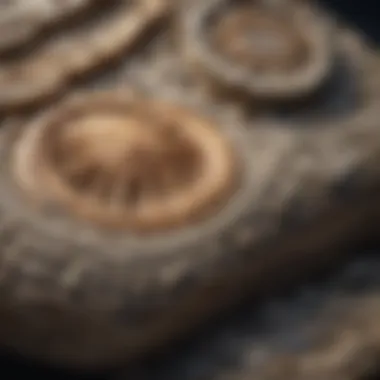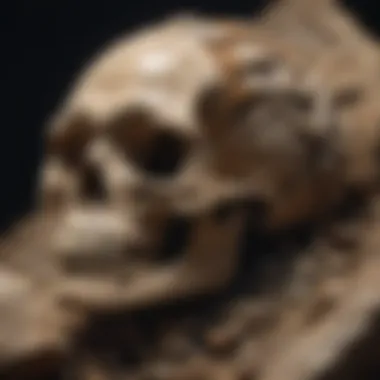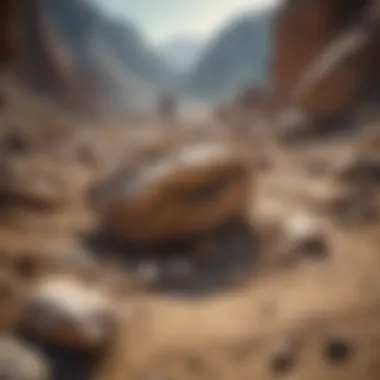Exploring Stones and Bones: The World of Fossils


Intro
The history of our planet is intricate, weaving through countless epochs and eras. At the heart of understanding this grand narrative are fossils—those captivating remnants of life that once thrived in diverse shapes and forms. Fossils serve as communication from the past, offering a glimpse into an age gone by. Among these, stones and bones fossils stand out, not just as collectibles, but as key pieces that unlock secrets of Earth's history.
When we talk about stones and bones fossils, we refer to the varied ways life has been preserved over millions of years. The processes involved in fossilization are complex and fascinating. From tiny footprints left in mud to massive dinosaur bones, each fossil has a story that connects us to a world we can barely imagine.
This article serves a dual purpose: it caters to both seasoned collectors looking to deepen their knowledge and enthusiastic newcomers eager to uncover the joys of fossil hunting. We’ll dive into the methods of fossilization, the types available for collectors, and the tools required for identification. By the end, you'll not only appreciate the beauty of these artifacts but also grasp their significance in our understanding of Earth's monumental past.
Intro to Fossils
Fossils serve as remarkable time capsules, revealing a wealth of information about our planet's history. This section sets the stage for a deeper understanding of fossils by delving into their definitions, importance, and the fascinating processes behind fossilization. For collectors, hobbyists, and scholars alike, unraveling the mysteries of fossils is not just a pastime but a pathway to understanding the Earth’s paleontological narrative.
Definition and Importance of Fossils
A fossil can be defined as the preserved remains, impression, or traces of organisms from the remote past. They can range from the bones of ancient dinosaurs to leaf imprints trapped in stone. The importance of fossils extends beyond mere curiosity; they act as critical indicators of ancient life, providing significant insights into evolutionary biology, ecology, and even climate change over the eons.
Key points about fossils include:
- Historical Insight: Fossils can illuminate how life forms have evolved over time, marking milestones in the tree of life.
- Environmental Indicators: They help scientists understand past environments and how changes have impacted living organisms.
- Cultural Relevance: Many cultures revere fossils as links to the past, enhancing our appreciation for natural history.
Understanding fossils aids in piecing together the tapestry of Earth's biological history, making them invaluable to both scientific research and personal collections.
The Science Behind Fossilization
The process of fossilization is a complex interplay of biological, chemical, and geological factors. For instance, when an organism dies, various conditions influence whether it will become a fossil. Typically, the key steps in fossilization include:
- Rapid Burial: After death, the organism often needs to be quickly buried by sediment. This quick covering protects the remains from scavengers and decay.
- Sediment Compaction: Over time, layers of sediment accumulate, exerting increasing pressure. This pressure compresses the layers below, including the buried remains.
- Mineralization: As water seeps through the sediment, it deposits minerals into the organic material, replacing it and creating a fossil.
- Time: The process generally spans millions of years, wherein the sediments turn into rock, encapsulating the fossils within.
"Fossilization is not just preservation; it’s a remarkable transformation that turns life’s remains into geological narratives."
It's a tale of chance—many organisms do not become fossils, which makes those that do particularly special. Notably, understanding how fossils form widens our perspective on geology and biology, connecting various scientific disciplines and enhancing our overall comprehension of Earth's history.
Types of Fossils
When it comes to the realm of fossils, understanding the various types is crucial. Not only does it broaden one’s perspective on ancient life, but it also lays the groundwork for appreciating how these relics of the past contribute to our comprehension of Earth's history. The distinction between body fossils and trace fossils, for example, serves to illuminate the diverse ways life left its mark on the planet. Comprehending these types allows enthusiasts and collectors alike to identify and contextualize their finds more effectively.
Body Fossils
Body fossils are perhaps the most recognized form of fossil. They encompass the actual remains of organisms, such as bones, teeth, shells, and even soft tissues in exceptional circumstances. Each body fossil acts as a puzzle piece, providing insights into the anatomy, diet, and habitat of ancient creatures. For instance, a mammoth tusk reveals much about its lifestyle and the environment it thrived in.
The process of mineralization is key during fossil formation, as organic material is gradually replaced by minerals from groundwater. This slow yet steady process allows scientists to obtain a clearer picture of extinct species. Each body fossil tells a story of survival, adaptation, and, ultimately, extinction. Collectors cherish body fossils, not only for their scientific value but also due to their aesthetic appeal; the intricate details preserved in these fossils can often be mesmerizing.
Trace Fossils
Trace fossils, while less visually striking than body fossils, hold their own unique significance. These fossils provide evidence of the activities and behaviors of ancient life, rather than the organisms themselves. Footprints, burrows, and even coprolites (fossilized dung) showcase the activities that occurred long before humanity walked the earth. They can indicate migration patterns, feeding habits, and social behaviors.
For example, a set of dinosaur footprints found in sedimentary rock can reveal much about their size, speed, and the environment in which they roamed. Trace fossils often require careful analysis and consider environmental context to interpret their implications fully. Collectors interested in this type often seek out sites where geological conditions best preserve these artifacts, as they are invaluable for understanding the daily lives of prehistoric creatures.
Stones versus Bones: A Comparative Overview
When discussing fossils, the terms stones and bones often arise, bringing forth a debate among fossil aficionados regarding their significance and utility in paleontology. On one hand, body fossils (bones) provide direct insight into the morphology and biology of extinct species. They are invaluable for creating detailed reconstructions of ancient creatures and understanding their evolutionary paths.
On the other hand, stones can refer to any mineralized remains, including those forming around organic matter, encapsulating ecosystems that would otherwise have been lost to time. Stones can contain myriad other life forms, from microorganisms to plants, allowing for a broader ecological perspective of ancient environments.
In essence, both body fossils and trace fossils contribute vastly different, yet equally vital, information about the ancient ocean depths and terrestrial landscapes. Collectors who appreciate both aspects can build a more holistic understanding of Earth's biological history.
Collectively, body and trace fossils complementary aspects that help paint the complex picture of life's evolution on Earth.
Understanding these distinctions not only enhances the appreciation for fossils but also emphasizes the importance of preserving both types for future generations. As such, when engaging in fossil collection, knowing what you’re looking for can significantly influence your approach and outcomes.
The Formation Process of Fossils
Understanding how fossils form is crucial for appreciating their value in our natural history. The process itself is intricately tied to environmental factors, geological forces, and biological interactions. Fossils are not just remnants of life; they are intricate time capsules, providing insights into past ecosystems. Essentially, comprehending this formation process helps us piece together the puzzle of life's evolution, revealing patterns that extend beyond mere mortuary history. By grasping how stones and bones become fossils, we not only celebrate their beauty but also recognize their significance in narrating Earth’s vibrant past.
Environmental Conditions Favoring Fossilization
The chances of an organism being fossilized hinge greatly on its surrounding environment. Various conditions help set the stage for fossilizing events:
- Burial Speed: Quickly burying an organism under sediment aids in its preservation. The longer it stays exposed to elements, the more likely it is to decompose.
- Water Presence: Many fossils are formed in aquatic environments where organisms sink to the bottom, creating layers that compact over time. For instance, in riverbeds or lake bottoms, sediments can encapsulate remains, safeguarding them.
- Chemical Composition: The nature of the sediments also matters. Alkaline conditions can slow down decomposition. Conversely, acidic environments might hasten degradation. Different locales yield different fossil types based on these chemical factors.
- Temperature and Pressure: High pressure and suitable temperature conditions further dictate how remains turn into fossils. Over millennia, the gradual weight of accumulating sediments compresses and alters the remains, turning them into rock-like features.


The blend of these elements forms the ideal recipe for fossilization, making certain conditions paramount. Even a simple change in one factor can shift the entire outcome, emphasizing the delicate balance of natural processes at work.
The Role of Sedimentary Rock
Sedimentary rock plays an essential role in the fossilization process. This type of rock, formed through the accumulation and compaction of sediments, acts like a protective vault for fossils. Understanding its significance involves several key points:
- Entrapment of Fossils: As sediments settle layer by layer, remains of flora and fauna can become trapped. Over time, these layers harden and transform into sedimentary rock, encapsulating the remains within.
- Preservation of Details: Sedimentary rocks commonly preserve minute details of fossils, including cell structures or skin patterns, allowing paleontologists to study the minutiae of ancient life.
- Indicator of Past Environments: The characteristics of sedimentary rocks can provide clues about the environments where they formed. For instance, presence of fossilized marine life in limestone suggests a former oceanic setting. This relationship helps reconstruct ancient habitats.
- Ease of Study: Sedimentary rocks are often more accessible to geologists and paleontologists than other rock types. This accessibility boosts the likelihood of fossil discovery and research, leading to a deeper understanding of Earth’s history.
"Understanding sedimentary rocks is not just about identifying minerals; it's about uncovering stories etched within layers of time."
In summary, the formation process of fossils is anything but simple; it's a complex interplay of biological, chemical, and geological factors. Recognizing how environmental conditions and sedimentary rock contribute to this natural wonder is key for fossil enthusiasts and collectors alike. They are not just stones and bones, they are windows into a time long gone. By appreciating the nuances of these processes, one can better value the stories fossils tell about our planet and its history.
Fossil Collection Techniques
Fossil collection stands as a pivotal component in the realm of paleontology and geology. This process not only allows enthusiasts and researchers to expand their understanding of ancient life forms but also preserves vital clues to Earth’s history. Collecting fossils responsibly can lead to significant discoveries that contribute to scientific knowledge. Therefore, grasping the essential techniques involved in fossil collection is paramount.
Legal and Ethical Considerations
Collecting fossils isn't merely a hobby; it comes with a set of crucial legal and ethical responsibilities. Many countries and regions have specific laws that govern fossil collection. It’s important to understand that not all fossils can be collected freely. For example, fossils found in national parks or protected lands require permission for any extraction. These regulations aim to protect fragile environments and maintain the integrity of geological sites.
When engaging in fossil collection, one must:
- Research local laws regarding fossil collection.
- Obtain needed permits when exploring regulated sites.
- Respect land rights, especially on private property.
Ethically speaking, collectors should aim to leave the area undisturbed. Removing too many fossils might have detrimental effects on local ecosystems or inhibit future research opportunities. Many experts advocate for collecting in a way that promotes education and conservation rather than exploitation.
"The thrill of discovery must be balanced with a commitment to preservation. Collecting fossils is not just about what one can take but also about what one can learn and protect."
Tools and Equipment for Collecting Fossils
When it comes to fossil hunting, having the right tools can make all the difference. While some collectors may embark on their expeditions with just a keen eye and a sturdy backpack, utilizing appropriate equipment can greatly enhance the effectiveness and success of the collection process.
Here’s a breakdown of essential tools:
- Geological Hammer: A durable hammer is key to breaking rock and extracting fossils. Choose one with a pointed end for prying, and a flat end for striking.
- Chisels and Picks: These instruments help in detailed extraction, especially when dealing with fragile fossils embedded in hard rock.
- Brushes: A soft-bristled brush is invaluable for cleaning fossils and removing loose particles without damaging the specimen.
- Field Bag: A sturdy bag is necessary to transport tools, collected fossils, and personal items. Look for one designed for outdoor use with multiple compartments.
- Safety Gear: Don’t forget safety glasses and gloves to protect yourself from potential hazards while you work.
Furthermore, keeping a field notebook to log locations, conditions, and notable finds can aid in future research or sharing experiences with others. Accessories like a GPS device can help you mark prime fossil sites worth revisiting later.
Properly equipping oneself for fossil collection not only maximizes finding potential but also underscores a responsible and informed approach to this engaging scientific pursuit.
Preservation of Fossils
In the realm of paleontology, the preservation of fossils is a pivotal aspect that cannot be overlooked. Fossils serve as time capsules, offering a glimpse into ancient worlds that otherwise might remain veiled in mystery. Preserving these remnants is not just a matter of keeping them intact; it’s about ensuring that future generations inherit the stories embedded in these stones and bones. For collectors and enthusiasts alike, understanding the importance of fossil preservation translates into a deeper respect for our planet’s geological history.
One of the primary benefits of fossil preservation is the ability to conduct ongoing research and analysis. As methods and technologies evolve, previously collected fossils can provide new insights through more sophisticated examination techniques. For example, advancements in imaging and genetic analysis can shed light on evolutionary pathways that fossils might suggest. If fossils are inadequately preserved, vital information can be lost, leaving a gap in the narrative of life on Earth. The preservation process also allows for the cultivation of a robust collection, contributing to broader scholarly work.
It's crucial to recognize several considerations in the preservation of fossils. Factors such as environmental conditions, display methods, and handling practices all play significant roles in determining the longevity of fossil specimens. Well-preserved fossils can become key educational tools in universities, museums, and even local exhibits, fostering a greater appreciation of history among diverse audiences.
Techniques for Long-term Preservation
When it comes to preserving fossils for the long haul, there are various techniques that hobbyists and professionals alike can use. Here are some effective methods:
- Temperature Control: Store fossils in a climate-controlled environment, as extreme temperature fluctuations can cause materials to expand and contract, leading to cracks.
- Humidity Management: Maintain an appropriate humidity level. Too much moisture can foster mold growth, while too little can dry out and deteriorate organic materials.
- Use of Acid-Free Materials: When creating displays or storage solutions, opt for acid-free boxes, tape, and paper to avoid chemical reactions that could harm the fossils.
- Regular Inspection: Periodically check on your fossils. Monitoring their condition allows for early detection of any issues, making corrective actions easier.
These techniques not only safeguard the fossils but enhance their educational value as well. Preserving them properly means they can tell their tales for many years to come.
Common Mistakes in Fossil Care
While preserving fossils sounds simple in theory, several pitfalls often trip up passionate collectors and researchers:
- Neglecting to Clean Properly: Fossils can accumulate dirt and substances that may cause degradation over time. However, overzealous cleaning with harsh chemicals or tools can also do more harm than good. A soft brush and mild soap typically work wonders without risking damage.
- Inappropriate Storage Conditions: Many collectors underestimate the dangers posed by improper storage. Keeping fossils in attics or basements can expose them to fluctuations in temperature and humidity, leading to unforeseen damage.
- Ignoring Protective Measures: Not using cases or displays to protect fossils during handling or showcasing can result in scratches or breaks that are irreversible. Proper enclosures can shield them from dust and potential impacts.
- Failing to Document: Not documenting the provenance or condition of fossils can lead to issues down the road. Proper records assist in tracking the history and care of the specimen, crucial for both personal collections and future research.
"The preservation of fossils is not just about saving stones and bones; it's about safeguarding history itself."
By being aware of these common mistakes and implementing effective preservation techniques, collectors can ensure that their treasures remain intact and informative, contributing to the broader narrative of life and earth's history.
Identification of Fossils
Identification of fossils is a crucial aspect of paleontology and geology that significantly enhances our understanding of Earth's history. This process not only encompasses recognizing individual fossil specimens but also entails understanding their broader implications in the context of ecological and geological changes over time. For collectors and enthusiasts alike, identifying fossils ensures that they can appropriately value, display, and conserve these remarkable remnants of life that once inhabited our planet.
The benefits of proficient fossil identification extend beyond mere aesthetic pleasure or an impressive collection. It holds scientific value, allowing researchers and hobbyists to contribute to the rich narrative of life on Earth. From deducing the characteristics of extinct species to providing insights into past climates, the identification of fossils serves as a key to unlocking the secrets embedded in the geological record.


When embarking on this identification journey, it’s vital to consider the characteristics and context of the fossils in question. Factors such as age, surroundings, and the processes that led to formation can all inform a collector’s approach to identification. This knowledge becomes a double-edged sword; while it can enhance the appreciation of fossils, a lack of understanding may lead to misidentification or misinterpretation, an aspect that every enthusiast must navigate with care.
Key Characteristics for Identification
Identifying fossils hinges on a variety of key characteristics. These can guide a fossil collector or a researcher in narrowing down the genus or species, effectively serving as visual clues crafted by nature over millions of years. Here’s a breakdown of some pivotal aspects to consider:
- Morphology: The physical shape and structure of the fossil can provide major insights. Are the lines and ridges distinctive? What’s the general form—shells, bones, or perhaps a leaf imprint?
- Texture: The texture of a fossil can tell a great deal about its origin. Is it smooth and polished, indicating potential transport before fossilization, or rough and angular, suggesting a more localized deposit?
- Coloration: The colors present can reflect the minerals incorporated during fossilization. For example, the rich reddish tones in some sandstones tell of iron-rich environments.
- Stratigraphy: The geological layers in which a fossil is found also provide context. Fossils in specific layers may correspond with certain historical epochs, allowing for dating and further identification.
- Size: The dimensions of a fossil often indicate its classification. For example, small mollusk shells typically fit into certain categories, while larger vertebrate bones indicate entirely different groups.
By paying attention to these characteristics, anyone can develop a sharper eye for recognizing fossils and appreciating their significance in the grand tapestry of Earth's history.
Resources and Tools for Enthusiasts
For those passionate about fossil identification, leveraging the right resources and tools can enhance the experience. Enthusiasts often find themselves in need of both printed materials and technical equipment to assist in their endeavors. Here are some noteworthy resources and tools:
- Field Guides: Books tailored to specific regions or types of fossils can be invaluable. For example, "The Fossil Book" by T. J. E. Smith encompasses both minor local finds and significant fossils, making it an ideal companion on field trips.
- Digital Resources: Websites such as Wikipedia and Britannica provide extensive background information and examples that can serve as quick references.
- Mobile Apps: Some applications allow identification by simply taking a picture of the fossil. These can save time and give insights almost instantly.
- Online Forums: Websites like Reddit and various Facebook groups dedicated to fossil collecting provide a platform for enthusiasts to share photographs and seek identification help from the community.
- Tools: Essential tools such as a magnifying glass, measuring tapes, and brushes for cleaning fossils can significantly help in the identification process. A quality rock hammer may also be needed for fieldwork.
Notable Fossil Discoveries
Fossils are like windows into the past, each one telling a story that connects us to life forms that roamed the earth millions of years ago. The topic of notable fossil discoveries is particularly vital in this discussion, as these finds not only deepen our understanding of biological evolution but also reveal the environmental shifts that have led to the present day. Through historic and recent discoveries, we gain insights that inform disciplines ranging from geology to ecology, all of which enrich our comprehension of the Earth’s history.
Historic Finds
Throughout the annals of paleontology, historic fossil discoveries have shaped scientific thought and sparked curiosity among both experts and enthusiasts alike. One of the most significant finds is the discovery of Archaeopteryx, often hailed as the first bird. This remarkable fossil, discovered in Germany in the 19th century, showcases the evolutionary link between dinosaurs and modern birds, offering a clear glimpse into the transition from non-avian reptiles to avians.
Another monumental discovery is that of the Iguanodon, a herbivorous dinosaur found in England. This find contributed immensely to our understanding of dinosaur behavior and physiology. The fossils revealed not only the physical structure of this creature but also hints at its way of life and habitat preferences.
These historic finds have laid the groundwork for future research. They have enabled generations of scholars to stitch together a more complete picture of life on Earth. Importantly, these fossils are often housed in renowned museums, serving as a beacon of education and curiosity for the public.
Recent Discoveries and Their Implications
In recent years, the pace of fossil discovery has not slowed down, with new finds reshaping our understanding of evolutionary timelines and biodiversity. The unearthing of the Woolly Mammoth in Siberian permafrost has garnered immense attention. As scientists analyze these well-preserved remains, they unlock secrets of how these magnificent creatures adapted to their environment, paving the way for insights into current species affected by climate change.
Moreover, the discovery of Homo naledi in South Africa has stirred debate regarding the human lineage itself. This species exhibits traits that blur the lines between what we once categorized distinctly as human and non-human. Its implications challenge long-held beliefs and excite researchers to further investigate how these early hominids navigated and thrived in their habitats.
Ultimately, these recent discoveries serve not only to fill gaps in our historical knowledge but also to pose new questions about biodiversity, adaptation, and extinction. Each fossil is a piece of a larger puzzle that scientists seek to solve, exploring how life has endured and transformed through millennia.
Notable fossil discoveries, both historic and contemporary, continue to illuminate the intriguing complexities of life on Earth. They stand as testament to the dynamic history of our planet, inspiring a deeper appreciation for the processes that have shaped all forms of life. As we reflect on these finds, we are reminded of the intricate web of connections that bind us across time.
The Role of Fossils in Understanding Earth's History
Fossils serve as a window into the prehistoric landscapes of our planet. They are not merely remnants of ancient life but valuable keys that unlock stories of Earth's environmental and biological past. By studying fossils, scientists can piece together climatic shifts, ecological changes, and evolutionary trends that have shaped life as we know it.
These vestiges are like breadcrumbs left behind, guiding researchers through the diverse epochs of geological history. One of the primary reasons fossils matter is that they provide context. For example, analyzing carbon dating from fossilized remains helps chronicle the timeline of various organisms and their interactions with each other and their environments. Thus, the role of fossils in understanding Earth’s history is akin to the role of a diary—capturing pivotal moments that define epochs, species, and ecosystems.
"Fossils are records of life—each one tells us about the past, guiding us closer to understanding our environment and ourselves."
In research, fossils help chart the rise and fall of species over millions of years. This information not only illuminates the present but also forecasts potential future changes. As paleontologists sift through layers of sediment, the patterns they uncover reveal periods of abundance and suffering among various life forms, giving hints about resilience and adaptation.
Fossils as Indicators of Past Environments
Fossils act as markers for the environments in which ancient organisms thrived. For instance, the presence of coral fossils indicates a warm marine environment, while large plant fossils can hint at once-lush, temperate forests. Each fossil can tell tales of climatic conditions that were prevalent when the organism lived. Studying these indicators allows researchers to infer details about temperature, precipitation, and even atmospheric conditions during different geological periods.
In addition, fossilized footprints and burrows serve as traces of interactions within ecosystems. These types of fossils inform us about predators and prey dynamics, showcasing how species adapted to their environments. Environmental changes reflected through fossils help draw connections between periods of stability and episodes of dramatic shift, such as mass extinctions or climatic upheavals.
Evolution and Extinction Narratives Through Fossils
The narrative of life on Earth is richly written in the form of evolution and extinction. Fossils are crucial in tracing the lineage and development of species. By examining transitional fossils, researchers can visualize and understand how organisms changed over eons. For instance, the discovery of the Archaeopteryx has provided pivotal insight into the evolutionary transition from dinosaurs to birds.
Moreover, the study of extinction through fossils also opens discussions about resilience and vulnerability in ecosystems. Major extinction events, such as the Permian-Triassic extinction, altered the course of life dramatically. Fossils from these times reveal how life rebounded or transformed following such catastrophic events. They also provide insight into modern biodiversity crises, offering lessons on adaptation and survival.
Interdisciplinary Approaches to Fossil Study
In the quest to unearth the mysteries held within stones and bones fossils, an interdisciplinary approach proves invaluable. This approach melds various fields, allowing researchers to gain a deeper understanding of fossils and their historical implications. By integrating techniques and insights from disciplines such as geology, paleontology, archaeology, and even chemistry, one can uncover hidden narratives and connections that might otherwise be lost in translation. This section emphasizes the benefits of such collaboration while drawing attention to some key considerations involved.
Integrating Geology and Paleontology
The synergy between geology and paleontology is fundamental in fossil research. Geology lays the groundwork by explaining how and where fossils are formed. For instance, sediment layers tell a story – their composition, age, and the environmental conditions at the time of deposition can reveal when a particular fossil was formed. On the flip side, paleontology helps decode these geological records. For fossil collectors, understanding the geological context of a find not only boosts its scientific value but also enhances the collector’s appreciation for the unique story each specimen holds.
Moreover, using geological principles, paleontologists can identify potential fossil-rich sites by studying rock formations. Some areas are known to yield rich deposits due to specific geological events. For example, the Morrison Formation in North America is famous for its abundance of dinosaur fossils, thanks to the sedimentary conditions that prevailed millions of years ago.


Collaborative Research Enhancements
Focusing on collaborative efforts can significantly amplify the outcomes of fossil studies. Collaborative research brings together experts from various backgrounds, enabling a more holistic view of fossils and their significance. For instance, partnerships among geologists, paleontologists, and bioarchaeologists enrich the analysis of fossils by incorporating biological perspectives.
- Benefits of Collaboration:
- Greater access to diverse expertise leads to comprehensive analyses.
- Cross-disciplinary perspectives can spark innovative research questions.
- Sharing resources increases efficiency and spreads the workload.
A concrete example is the recent collaborative project involving geologists and paleontologists at the University of California, Berkeley, aiming to study the sedimentary environments of fossil-bearing strata. Their combined insights have led to a deeper understanding of ecosystems during various geological eras.
As scientists draw those lines between distinct fields, they often find themselves crossing paths with technology. Harnessing sophisticated tools like 3D modeling, imaging techniques, and advanced software for data analysis enhances traditional fossil study methods, making them more fine-tuned and less prone to human error.
"Collaboration in fossil research isn't just beneficial; it's becoming indispensable to understanding our planet's history better than ever before."
The future of fossil research, therefore, looks bright with interdisciplinary collaboration paving the way for discoveries that could reshape our understanding of Earth’s rich tapestry. As the fields converge, fossil collectors stand to gain immensely, as each specimen tells a part of our planet's history, inviting us to explore further and dive deeper.
Community and Collectors' Perspectives
The study of fossils is not merely an academic exercise, but a vibrant community of enthusiasts and collectors who breathe life into the world of paleontology. Engaging with local fossil groups and collectors creates a rich tapestry of knowledge, experience, and shared passion. This section explores why these interactions are invaluable to both seasoned professionals and budding enthusiasts alike.
Engaging with Local Fossil Groups
Local fossil groups serve as more than just clubs; they are the lifeblood of the fossil-collecting community. Joining these groups often means tapping into a wealth of expertise. Members frequently share tips and tricks on various aspects of fossil collection, from identifying valuable specimens to the latest locations where fossils can be found.
- Knowledge Sharing: Over time, fossil enthusiasts accumulate a treasure trove of insights, often informally. When members come together, discussions can range from the latest fossil finds to techniques in preservation. The collective wisdom found within these groups can greatly enhance an individual's collecting skills.
- Field Trips: Most local groups organize field trips to prime fossil-hunting sites. This hands-on experience is irreplaceable. A novice might discover a new love for the science behind fossils just by picking up a beautiful ammonite under guidance.
- Networking: Meeting others in the field creates opportunities for mentorship and partnerships. Collectors often share leads on rare finds or even trade specimens. Over time, these connections can blossom into lifelong friendships.
Sharing Knowledge and Experiences
The act of sharing knowledge and experiences is pivotal in fostering a vibrant community of fossil enthusiasts. While individuals gather their own finds, the practice of discussing and documenting these experiences brings dynamism to the community.
"Every fossil has a story behind it. By sharing, we're not just trading specimens; we're linking history to our present and setting the stage for younger generations."
- Documentation: Many collectors document their discoveries. This practice often leads to valuable information being recorded for future reference. Collectors can keep a journal of their finds, complete with locations, dates, and photographs—becoming the storytellers of fossil history.
- Workshops and Presentations: Local groups sometimes hold workshops or invite experts to share their insights. Whether it’s learning about the processes of fossilization or the classification of specimens, these experiences enrich the entire community.
- Online Platforms: Platforms like Reddit and Facebook have also become integral for fossil collectors. They provide a space to share discoveries and ask questions, expanding interactions beyond geographical borders.
In summary, the community aspect of fossil collecting, enriched through engagement with local groups and shared experiences, is essential for the growth and vitality of the field. Together, collectors contribute to a comprehensive understanding of our planet's deep history while nurturing the next generation of fossil enthusiasts.
Future Trends in Fossil Research
The journey into the world of fossils does not halt with the discovery and analysis of previous eras. As times change, so too does the field of paleontology, embracing new methodologies and challenges. The future trends in fossil research hold paramount importance not only for geologists and paleontologists but also for collectors and enthusiasts alike. This section will explore the pivotal elements that seem to shape the direction of this field, including the role of technological advancements and the shadow of climate change looming over fossil discovery.
Technological Advancements in Fossil Analysis
The tools used in fossil analysis are evolving at breakneck speed. New technologies are surfacing every year, offering more refined and detailed insights into our ancient past. Take, for example, computed tomography (CT) scanning. This technique produces high-resolution images of fossils, allowing researchers to examine the intricate structures without causing any harm. In essence, it gives a sneak peek into the fossilized remains, revealing details that were once only imaginable.
Beyond CT scanning, developments in digital imaging and 3D printing are reshaping how fossils are studied. With 3D modeling, researchers can create a digital copy of a fossil, enabling collaborative studies across the globe without needing to ship delicate specimens. This technological revolution does not just enhance analysis but opens doors to more educational opportunities for both scholars and hobbyists.
In addition, advanced dating techniques like radiometric dating and luminescence dating provide more accurate timelines of fossil origins, helping experts fill the gaps in our understanding of evolutionary processes. Overall, the integration of cutting-edge technologies into fossil analysis not only unravels the past but also ignites interest among those keen to dive deeper into paleontological studies.
Implications of Climate Change on Fossil Discovery
To put it bluntly, climate change is reshaping landscapes, and along with it, the world of fossils. As temperatures rise and weather patterns shift, previously inaccessible regions become open for exploration. However, it’s a double-edged sword. As glacial ice melts or forests recede, fossilized remains are exposed, but many invaluable specimens may also erode or become destroyed. It creates a race against time for researchers and collectors looking to gather historical context before it slips through their fingers.
Moreover, various studies have suggested that some fossils serve as indicators of ancient climates. By understanding how certain species thrived in varied conditions, scientists aim to piece together what future climates might look like and how current species might respond. Thus, the act of fossil discovery is no longer about just digging up old bones but involves grappling with the immediate implications of climate change on our understanding of ecological shifts.
"Fossil discovery is at a crossroads, where each find may tell us not just about the past but also about the future of our planet."
As collectors, enthusiasts, and researchers, it’s crucial to acknowledge these trends shaping fossil research. Engaging with the idea that through technology and environmental awareness, we can not only preserve history but also safeguard it for future study. It’s a pivotal time for the field, replete with both challenges and opportunities.
The End
Fossils are not just remnants of the past; they are vibrant storytellers that reveal the intricate saga of life on Earth. In this article, we have journeyed through the multifaceted processes that give rise to these stones and bones, emphasizing their significance in understanding geological eras, climatic changes, and evolutionary narratives.
The Ongoing Journey of Fossil Study
The study of fossils is akin to piecing together a jigsaw puzzle that seems almost infinite. Every year, fossil hunters and scientists alike contribute to uncovering fragments of that puzzle, which often leads to surprises, new theories, and deeper questions. For instance, discoveries like the exceptionally well-preserved Opabinia from the Burgess Shale bring forth new debates about the evolutionary lineage and adaptations of early life forms. Such finds fuel both enthusiasm and curiosity, inviting interest from not just professionals, but also amateurs who seek to understand the Earth's history.
What enhances this ongoing journey is the growing collaboration among disciplines. Geologists, paleontologists, and even botanists converge, sharing insights that lead to an enriched understanding of our planet’s history. The cross-pollination of ideas from varying fields results in a more cohesive narrative about ancient environments and the life they harbored. However, this journey is far from over, as the remnants of life continue to beckon from the depths of both land and sea.
Encouraging Further Exploration
The insights shared throughout this article hint at the boundless exploration opportunities available within the field of fossils. Collectors—either fledglings or veterans—are encouraged to engage not just with their findings but also with the broader context of paleontological research. Visiting local museums, joining fossil clubs, or even attending workshops can be invaluable. These are platforms for sharing experiences and expanding knowledge, ensuring that fossil study remains vibrant and accessible.
Moreover, online communities on platforms like Reddit or Facebook provide instant connections to like-minded individuals who can help dispel doubts, offer tips, and celebrate new discoveries. Local geology clubs often organize field trips, presenting ideal opportunities for enthusiasts to witness fossilization processes up close.
As interest in fossils continues to rise, particularly regarding the intersection with climate change, there has never been a better time to dive deeper into this captivating field. Each fossil collected holds the potential to illuminate aspects of Earth’s evolution, making it vital for both understanding our past and preparing for our future.
Ultimately, the fascination with stones and bones is rooted not merely in their existence but in what they reveal: a timeless connection to life itself and the landscape that cradles it. As you go forth, let curiosity guide your hands and your heart, for there are countless chapters yet to be uncovered.



